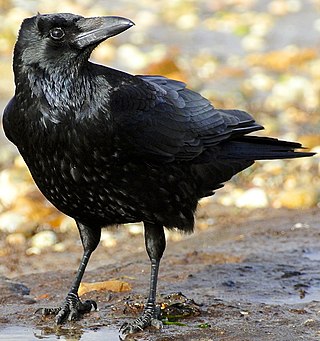
The carrion crow is a passerine bird of the family Corvidae and the genus Corvus which is native to western Europe and the eastern Palearctic.

The hooded crow, also called the scald-crow or hoodie, is a Eurasian bird species in the genus Corvus. Widely distributed, it is found across Northern, Eastern, and Southeastern Europe, as well as parts of the Middle East. It is an ashy grey bird with black head, throat, wings, tail, and thigh feathers, as well as a black bill, eyes, and feet. Like other corvids, it is an omnivorous and opportunistic forager and feeder.
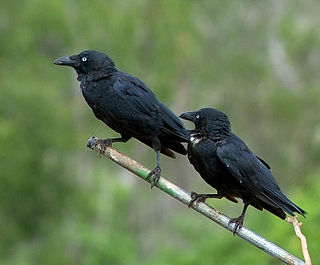
The Torresian crow, also called the Australian crow or Papuan crow, is a passerine bird in the crow family native to the north and west of Australia and nearby islands in Indonesia and Papua New Guinea. The species has a black plumage, beak and mouth with white irises. The base of the feathers on the head and neck are white. The Torresian crow is slightly larger with a more robust bill than the morphologically similar little crow.

The little crow is an Australian species of crow, very similar to the Torresian crow in having white bases to the neck and head feathers but slightly smaller and with a slightly smaller bill. It has the same white iris that distinguish the Australian species from all other Corvus except a few island species to the north of Australia, and one from Eurasia, the jackdaw. Like the Australian raven, this species has a blue ring around the pupil.

The little raven is a species of the family Corvidae that is native to southeastern Australia. An adult individual is about 48–50 cm (19–19.5 in) in length, with completely black plumage, beak, and legs; as with all Australian species of Corvus, the black feathers have a grey base, and the iris of the adult bird is white . Although the little raven was first named by Gregory Mathews in 1912, it was only in 1967 that there was consensus to separate it from the Australian raven as a distinct species.

The pied crow is a widely distributed African bird species in the crow genus.

The house crow, also known as the Indian, greynecked, Ceylon or Colombo crow, is a common bird of the crow family that is of Asian origin but now found in many parts of the world, where they arrived assisted by shipping. It is between the jackdaw and the carrion crow in size but is slimmer than either. The forehead, crown, throat and upper breast are a richly glossed black, whilst the neck and breast are a lighter grey-brown in colour. The wings, tail and legs are black. There are regional variations in the thickness of the bill and the depth of colour in areas of the plumage.

The American crow is a large passerine bird species of the family Corvidae. It is a common bird found throughout much of North America. American crows are the New World counterpart to the carrion crow of Europe and the hooded crow of Eurasia; they all occupy the same ecological niche. Although the American crow and the hooded crow are very similar in size, structure and behavior, their calls and visual appearance are different.
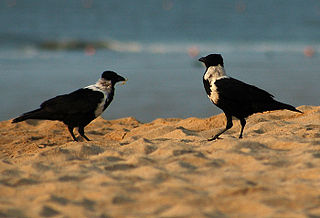
The collared crow, also known as the ring-necked crow or white-collared crow, is a member of the family Corvidae native to China and north of Vietnam.

The fish crow is a species of crow associated with wetland habitats in the eastern and southeastern United States.

The Tamaulipas crow is a crow found in northeastern Mexico and southern Texas.

The fan-tailed raven is a passerine bird of the crow family native to Eastern Africa and the Arabian Peninsula.

The brown-necked raven is a larger bird than the carrion crow though not as large as the common raven. It has similar proportions to the common raven but the bill is not so large or deep and the wings tend to be a little more pointed in profile. The head and throat are a distinct brownish-black giving the bird its English name, while the rest of the plumage is black glossed with purple, blue or purplish-blue. Like the common raven, thick-billed raven and white-necked raven, it is one of the larger raven species. The feathers of this species often fade quite quickly to a brownish black and the bird can look distinctly brown by the time it moults. The feet, legs and bill are black. The dwarf raven was formerly considered a subspecies but this bird now appears to be closer to the pied crow than this species.

The large-billed crow, formerly referred to widely as the jungle crow, is a widespread Asian species of crow. It is very adaptable and is able to survive on a wide range of food sources, making it capable of colonizing new areas, due to which it is often considered a nuisance, especially on islands. It has a large bill, which is the source of its scientific name macrorhynchos and it is sometimes known by the common name thick-billed crow. It can also be mistaken for a common raven. Johann Georg Wagler first described the species from a holotype obtained from Java in the year 1827. The eastern jungle crow and Indian jungle crow were once considered conspecific and together called the jungle crow.
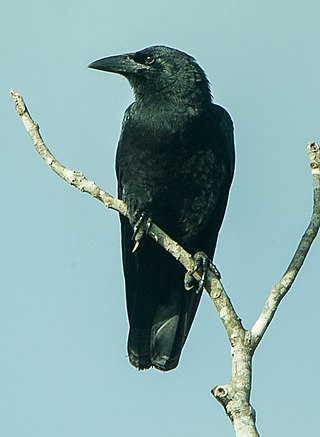
The Cuban crow is one of four species of crow that occur on islands in the Caribbean. It is closely related to the white-necked crow and Jamaican crow, with which it shares similar features. The fourth Caribbean crow, the palm crow, is a later arrival in evolutionary terms, and shows characteristics more akin to North American species, such as the fish crow, which it is probably closely related to.
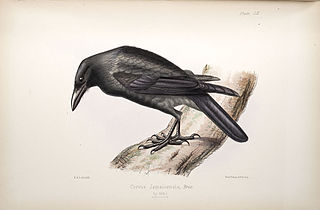
The Jamaican crow is a comparatively small corvid. It shares several key morphological features with two other West Indian species, the Cuban crow and the white-necked crow of Hispaniola, which are very closely related to it.

The white-necked crow is the largest of the four Caribbean corvids. It is endemic to the island of Hispaniola ; it was formerly also extant on Puerto Rico, but has been extirpated there due to considerable forest clearance and hunting.

The palm crow is a relatively small corvid that occurs on the Caribbean island of Hispaniola and Cuba, where it was formerly very frequent, but is now reduced in population.

The rook is a member of the family Corvidae in the passerine order of birds. It is found in the Palearctic, its range extending from Scandinavia and western Europe to eastern Siberia. It is a large, gregarious, black-feathered bird, distinguished from similar species by the whitish featherless area on the face. Rooks nest collectively in the tops of tall trees, often close to farms or villages, the groups of nests being known as rookeries.

The Somali crow, or dwarf raven, is approximately the size of the carrion crow, Corvus corone but with a longer bill and a somewhat more brownish cast to the feathers, especially when worn.






















